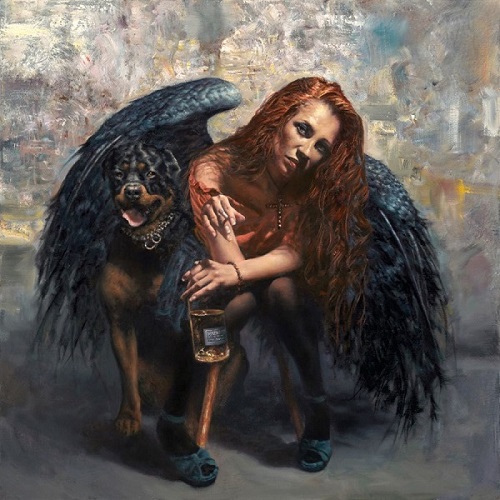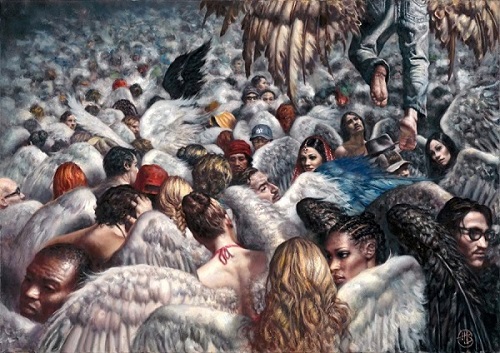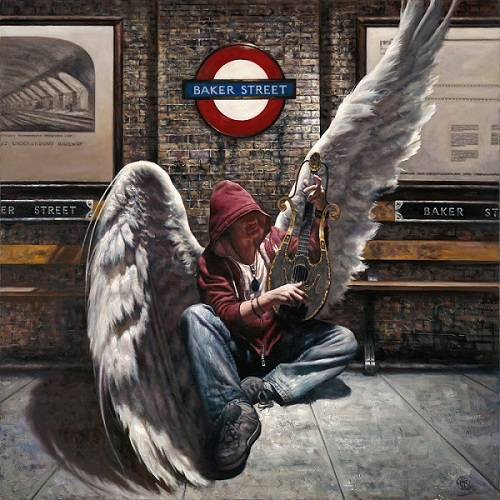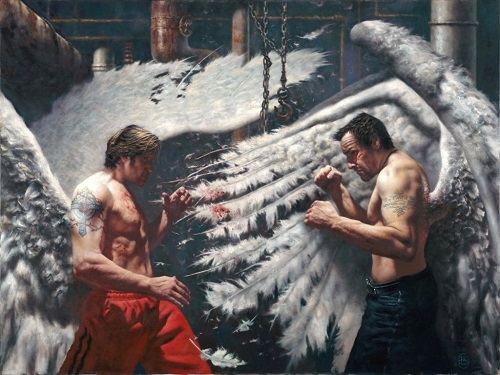by Carolyn Edlund
Hamish Blakely’s masterful series of paintings of fallen angels won an award from Manhattan Arts in their “New Beginnings” competition, and further recognition by Artsy Shark for his concept and body of work. I recently interviewed him about this complex and meaningful collection.

“Ol-faithful” oil on canvas, 86.5 cm x 86.5 cm. Blakely describes this piece, “The direct gaze of this red-haired Angel tells the viewer to approach with caution. Despite falling on hard times, there is nothing vulnerable about her and she has her faithful sidekick to reinforce the point.”
AS: How did you develop the concept behind the “Out of Work Angels” series?
HB: I have wanted to paint Angels for many years and just had to wait for the right angle. The familiar depiction of white robes, haloes and trumpets did not need repeating, so I wanted to create a body of work that was relevant and contemporary. Reports in the media of the younger generation’s disenchantment with the Church was the perfect catalyst. As they turn their backs on the Church in increasing numbers, this initial idea evolved to explore the theory that people’s apathy and lack of faith had direct repercussions in Heaven. Heaven’s creatures were now in a state of flux, descending to Earth, having been forsaken by humanity. Our once eternally loyal guardians found themselves changing, and as their identity begins to disintegrate, they urge the viewer to ask: What if they become like us?

This painting relates well to current events. Blakely says, “Unemployed Angels are cramming every border patrol at every airport in the country and now the world has to face the consequences of its lack of faith.”
AS: Temptation plays a big part in the theme of many of your paintings. One gets the feeling that these angels aren’t “bad” but perhaps are seeking rather than sinning. What is the intention behind the titles you have chosen and the literal “writing on the wall” in several of the paintings?
HB: They are in conflict, which we human beings are wrestling with our entire lives. The quest for bettering oneself, the desire, to evolve, increase self-awareness is all prey to obstacles and temptation. These temptations could simply be the ease with which we fall back into old, unwanted habits. It is no coincidence that when we are on any path to enlightenment, we will face obstacles that try to throw us off course. These can be self-induced as well as external. Whichever they are, it just means we have a bit of a battle on our hands which takes vigilance and great introspection to overcome. The Angels in my paintings are also confronting these struggles as well as discovering their sexuality, which is traditionally banned from the concept of these ethereal creatures altogether. However, one could not look at these beings sharing human characteristics and exclude sexuality.

“Baker Street Blues” oil on canvas, 138 cm x 138 cm. Blakely describes this scene, “For the most part, people are in too much of a rush, they are too self-involved to entertain the possibilities of a universe containing other realms; but this musical guardian from the sky does not mind. “
AS: Angels have been portrayed by artists many times throughout history, but your collection of fallen angels is the polar opposite of most imagery. Was there historical consideration involved when planning and creating your paintings?
HB: There was indeed. I was particularly drawn to the Biblical paintings of Caravaggio who, in fact, was not a million miles away from the concept of my unemployed Angels. Caravaggio’s work had a great respect for reality and he discarded sentiment and over glorification. Many times he used peasants as his models so he was driven by undoing what had gone before, by producing majestic, gritty work. He was, of course, a genius and continues to inspire many realistic artists.

“To the Bone” oil on canvas, 120 cm x 160 cm by Hamish Blakely
AS: Your painting “To the Bone” is a compelling piece in this series that begs to tell a story. What was your idea behind it?
HB: As part of the theme of Angels finding themselves redundant, some of them would naturally find alternative employment. In the case of these two pugilists, they have found themselves in the criminal world of bare-knuckle fighting. Exploitation is something these falling Angels could be prey to and what better spectacle of the blood sport of street boxing than a pair of hungry, down on their luck Angels to get the crowd baying and cheering?
The old tanks in the background hint at a disused warehouse or old boiler room, some place where the musty, dark atmosphere suits the mood of its guests. The huge hook in the middle of the painting symbolises the threat and brutality of this line of work and the viewer can see clear evidence that these two characters have been having a good go at each other already.
Who will the victor be? Who should be the last man standing? Are they siblings, and is this a bitter rivalry that needs to be settled?
There is also another dimension to this piece and that is a symbolic one. This could be a metaphor for the inner conflict we all face: the taming of our demons, reconciling past grievances to clear the way for a clearer present and future. We fight with ourselves and any process of enlightenment and spiritual evolution will involve some mental and emotional skirmish at some point. These two men could signify that very battle, the fight common to all those interested in self-awareness and emotional maturity. It is hard fought and ongoing, but mastery over the self is assured if one stops trying to battle alone and just asks the Universe for help.
Learn more about Hamish Blakely and view his portfolio by visiting his website.




Speak Your Mind